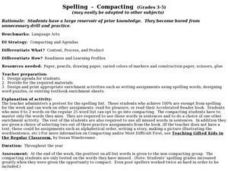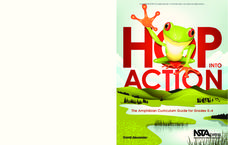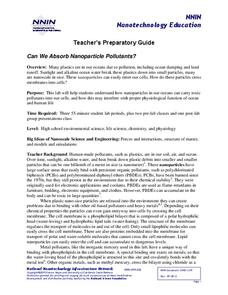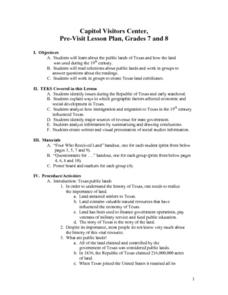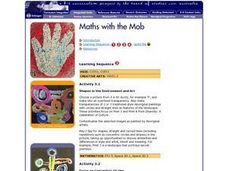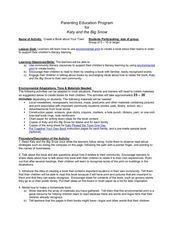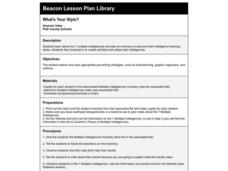Curated OER
Monster Symmetry
Third graders understand what a line of symmetry is and how to draw symmetrically. In this monster symmetry lesson, 3rd graders create an original monster that is symmetrical. Students participate in additional symmetry activities.
Curated OER
Candy Land
In this activity students pretend that they have been hired by a candy manufacturer to design a box for a new product they are beginning to market. The manufacturer has pre-determined the volume of the candy box. It is the students' job...
Curated OER
Presidential Trading Cards
Young scholars research the Internet to collect data about the US Presidents. They use the data that they collect along with available technology to produce trading cards and brochures using keyboarding skills, text boxes, acquiring...
Curated OER
My Many Colored Days
Students read My Many Colored Days as a class, explore their feelings about colors, illustrate what they think about colors, explore the author Dr. Seuss, and create an accordion style book.
Curated OER
Shapes (Orienteering)
Students explore the tools of navigation. In this shapes instructional activity, students navigate using direction cues to create a shape. Students follow specific steps to create their shapes. Students use compasses to see...
Curated OER
Spelling - Compacting (Grades 3-5)
Students use compacting when learning spelling words. In this spelling lesson, students take a pre-test on their weekly spelling words. Students who score 100% are exempt from spelling and those who miss 0-2 words compact their studying...
Curated OER
Don't Lose Your Way in the News
Students explore language arts by participating in a newspaper analysis activity. In this journalism lesson, students identify how newspapers present stories, who is writing them and how they can obtain information from them....
Curated OER
Animal Signs
Students discuss the many different types of animal signs that can be used to identify and track animals. They participate in an hands-on activity in which they examine tracks, trails, homes, territory markings, and even "scat" left by...
Curated OER
Heaven or Ground Hog Day?
Students discover the ideas of enlightenment by reading historical poetry. In this philosophical lesson, students read poems by Sir Walter Scott and Sergeant Joyce Kilmer while discussing the themes of the writing with classmates....
American Farm Bureau Foundation for Agriculture
Shapes in Agriculture
It's time to get crafty with shapes! Your future farmers demonstrate their geometric ability by building a farm using triangles, circles, rectangles, and squares. But first, scholars take part in a brainstorm session inspired by their...
Baylor College
Post-Assessment: Global Atmospheric Change
Find out how much your earth scientists learned about the atmosphere in the unit on global atmospheric change with this assessment. After writing a letter to persuade others to make changes to protect our atmosphere, pupils take the same...
Cornell University
Catapults
Ready, aim, fire! Launch to a new level of understanding as scholars build and test their own catapults. Learners explore lever design and how adjusting the fulcrum changes the outcome.
Baylor College
Needs of Living Things: Post-Assessment
Assess your class's knowledge of the needs of living things with the final lesson in a series. Given a large piece of paper and coloring utensils, young scientists draw a picture of themselves and a plant or animal of their choosing,...
National Science Teachers Association
Hop into Action
Young scientists find out what makes amphibians such unique and interesting animals in this simple life science lesson plan. After looking at pictures and discussing the characteristics of amphibians, learners complete a...
Roald Dahl
Matilda - Throwing the Hammer
Full truth, or an exaggeration? How can you tell when a storyteller is exaggerating a story? Readers analyze a story told by Hortensia, and identify the exaggerative language she uses. Then, learners write their own narrative story using...
California Education Partners
We Are The Ship
An assessment sheds light on scholars' ability to read, gather evidence, and draft an original written composition. Learners read an informative text twice before taking notes and discussing their thoughts and textual evidence with a...
National Nanotechnology Infrastructure Network
Can We Absorb Nanoparticle Pollutants?
Just because we can't see it doesn't mean it isn't there! A growing concern for environmental scientists is toxic nanoparticles in our air and water. Young scholars conduct an experiment to demonstrate how these particles can cross our...
Curated OER
Young and Restless in China
Students examine push and pull factors at work in China. In this modern China lesson, students research primary and secondary sources in electronic and print formats to investigate the plight of migrant workers in China today. Students...
Curated OER
Harvesting Hope--Asking for Change Letters
Second graders compose friendly letters. In this writing lesson, 2nd graders read the text Harvesting Hope: The Story of Cesar Chavez and discuss the rights of farm workers. Students brainstorm things at school they would like to change...
Curated OER
Make Bark and Leaf Rubbings
Students explore natural resources by creating art from plant materials. In this leaf rubbings lesson, students identify the plants that shed bark and leaves and discuss how it helps them survive in specific environments. Students...
Curated OER
Capitol Visitors Center, Pre-Visit Lesson Plan, Grades 7 and 8
Young scholars, through lecture and discussion, identify public lands of Texas and how the land was used during the 19th century. They read selections about public lands and work in groups to answer questions about the readings. In...
Curated OER
Maths with the Mob - Aboriginal Culture
Students read and discuss books about aboriginal family life. Working individually and in groups, they complete a series of activities in various subject areas, including art, language, math, and social studies. Among the activities ...
Curated OER
Create a Book About Your Town
Students explore how to create books about their towns. They read and discuss Katy and the Big Snow to identify how it relates to their community. They identify environmental print and its importance in early readers. They create books...
Curated OER
What's Your Style?
Pupils examine and discuss the seven multiple intelligences. They take an inventory to identify their own learning styles and design activities that utilize their intelligences.





